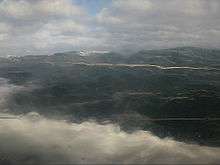White squall

A white squall is a sudden and violent windstorm at sea which is not accompanied by the black clouds generally characteristic of a squall. The name refers to the white-capped waves and broken water, its meager warning to any unlucky seaman caught in its path. White squalls are rare at sea, but common on the Great Lakes of North America.
A white squall is the culprit of many sea stories and blamed for quite a few tragedies. It is described as a sudden increase in wind velocity in tropical and sub-tropical waters, and lacks the usual dark, ominous squall clouds. The white squall may be a microburst.[1]
Historical incidents
- The Pride of Baltimore, a modern 137-foot (42 m) schooner, was reportedly struck by a white squall on May 14, 1986. The 121-ton vessel sank about 240 miles (390 km) north of Puerto Rico, casting the surviving crew members adrift for five days. The Toro, a Norwegian freighter, picked them up at 2:30 a.m. May 19, 1986. An eyewitness account described it as follows:
"A tremendous whistling sound suddenly roared through the rigging and a wall of wind hit us in the back. The Pride heeled over in a matter of seconds. The 70-knot (130 km/h) wind pushed a 20-foot (6.1 m) high wall of water into the starboard side. She sank in minutes."
″As described a white wall rose in front of our cruise vessel the Norwegian Gem as we were out in Boston in 2011, the ship listed 13 degrees to the port side as the wind started to blow out of nowhere and we could observe how the water rose upwards creating a white wall coming toward us.″
- A white squall was allegedly behind the sinking of the brigantine Albatross on May 2, 1961.
- A white squall was responsible for the sinking of the German training vessel Niobe on 26 July 1932.
- A white squall is also believed to have sunk the schooner Hunter Savidge on Lake Huron in 1899.
In popular culture
- Stan Rogers wrote his 1984 song "White Squall" about the white squalls of the Great Lakes.
- Ridley Scott's film White Squall tells the story behind the 1961 sinking of the Albatross.
See also
References
- ↑ USA Today: "Answers: Oceans, waves, tides." Retrieved March 21, 2007.